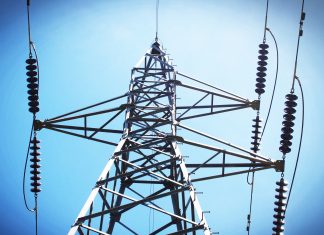 |
|
| Issue #116 • March/April, 2008 |
A typical residential-size solar system installation will involve properly sized and installed AC and DC electrical wiring to reduce the risk of electrical fire, a proper grounding system to prevent shock and lightning damage, proper battery installation and venting to prevent gas explosions, and a properly installed solar array to maximize performance while avoiding roof damage.
In almost all of my past articles I have described many different types of solar power systems, but did not go into detail on how to install them yourself, since most systems should be sized and wired by licensed solar professionals. However, the Backwoods Home website continues to receive many e-mail questions related to smaller do-it-yourself solar projects for remote weekend or vacation cabins in areas not served by power lines. If this is your situation, and you are willing to stick to the basics, I will show you how to install a very simple battery-based off-grid solar system just to power a few lights, and possibly a DC well pump or freezer.
Otherwisedon’t try this at home.
I am staying with all 12-volt DC equipment which has a limited shock hazard and allows using many of the electrical components you can find locally. However, a word of warning. Just because everything will be the same low voltage wiring as used in your car or boat, this still does not mean there are no safety concerns.
|
Any deep-discharge battery contains hundreds of amps of stored energy that can easily melt heavy gauge wire or electrical components if not sized and installed properly. I have seen electrical cable the size of your thumb quickly glow red and melt due to an improperly installed battery. This glowing cable could easily ignite any nearby walls, floors, or roofs.
This means if I say to use a specific type or size component, there is a really good reason. You should not assume you can substitute anything you have lying around that is “almost the same.” If you want to really simplify the equipment selection, all of the components required are available in pre-packaged solar lighting kits of various sizes.
Battery sizing
The first decision we need to make is system size. If you only need to power a few lights in two or three rooms in a remote cabin, then you can get by with one or two 12-volt batteries. If you want to also power a small DC freezer or DC well pump, then you will need two to four 6-volt batteries. Do not, under any circumstances, use standard car or truck batteries, as they have very thin lead plates to reduce weight and they will not last long under daily cycling.
Normally in this application I would recommend using either 12-volt RV/marine batteries or 6-volt golf-cart batteries. These are available locally and are fairly inexpensive. However, if you purchase the sealed GEL or AGM version, this will significantly reduce any risk of vented explosive gases or the need for battery maintenance. Sealed batteries cost almost 40% more than the same size open cap batteries that require watering, and they do not last any longer. However, since you will not need to build a special battery room or vented enclosure, this will be an advantage in a smaller cabin installation with limited storage space. Regardless of battery type, the battery bank should be insulated in colder regions since battery charge drastically drops when it gets below 35 degrees.
Solar array
The size and number of solar modules needed depends on the capacity of your battery bank and where your off-grid cabin will be located. If possible, you want the solar array to face south. In my geographic area, most mornings are foggy and late afternoons are blue-sky sunny, so I favor a slightly southwest orientation.
A solar module produces the best year-round performance with a tilt angle equal to your latitude. A lesser angle will improve summer output, and a steeper angle will do better in winter. For most of the United States, this is from 37 to 42 degrees. If your cabin will only be used for part of the year, you should use the tilt angle that will produce more energy during that part of the year.
Your solar array can be mounted on your cabin’s roof, on a nearby pole, ground-mounted on a raised frame, or mounted on a nearby storage shed. Solar modules are fairly lightweight so your main mounting concern is wind uplift, not caving in your roof. Any mounting system should use only stainless-steel bolts or lag screws penetrating into rafters or blocking, since a strong wind will easily pull out any screws that only penetrate sheeting plywood.
Array sizing
|
Most of the 12-volt solar modules sold today are smaller than 100 watts. The current market trend is for larger modules, which require a nominal 24 volt output. One deep-cycle 6-volt golf-cart battery or 12-volt RV battery will store approximately 1 kWh of electricity when discharged 50%. As a rough estimate, this means you will need about 200 watts of solar array to recharge one battery in one day, assuming five hours of direct sunlight.
This is typical for most summer months, but for many parts of the northern United States, you may only receive three hours of direct sun during short winter days. This means you will need to increase the solar array to battery ratio, or simply reduce your power usage during periods of cloudy weather.
There are many design problems associated with multiple “parallel” wired solar modules and batteries, so it is much easier to use larger-capacity solar modules and batteries than smaller ones. Keep this in mind when purchasing batteries and solar modules. Ordering larger unit sizes will work out better in the long run than buying the smaller and cheaper brands typically found locally.
Wiring safety
You need to understand that the same watt size electric loads at 120 volts AC require 10 times the amp current at 12 volts DC. Watts for a given load do not change regardless of voltage, so two 100-watt light bulbs that require 1.7 amps at 120 volt AC (200 watts/120 volts), can be wired using a #14 size wire which has a 15 amp rating. However, at 12 volts DC, this same load will draw 17 amps (200 watts/12 volts), which exceeds the #14 wire’s 15 amp rating.
In addition, these two 100-watt light bulbs would only operate about five hours before draining your deep-cycle battery (5 hrs x 100 watts x 2 bulbs = 1 kWh). So right from the start you need to use only the most efficient DC lighting and DC appliances you can buy, and do not base your wire sizing on 120-volt AC loads.
Just because we are using low voltage DC power does not mean we do not need fuses or circuit breakers. Each wire supplying a load in your cabin must have a properly sized fuse or circuit breaker to prevent overload and possible fire.
Normally you will find a DC rated fuse or circuit breaker to be physically larger and more expensive than the same amp size AC device. It is also much harder to find a local supplier for DC rated circuit breakers. However, we are in luck since the Square D “QO” line of AC circuit breakers are also dual rated for up to 48 volts DC, but this only applies to the “QO” line by Square D.
|
I am not aware of any other low cost circuit breaker typically found in a local builder supply that is also rated for low voltage DC service. I suggest using the eight circuit Square D “QO” subpanel and single-pole 10 or 15 amp “QO” circuit breakers for all your load wiring. You may be tempted to use lower cost automotive type DC fuses, but these are not approved for residential wiring. Your local RV or boating supply store will have a great selection of 12-volt DC lighting fixtures that should easily meet all your lighting needs. These are also available in weatherproof designs for outdoor lighting applications. Purchase DC light fixtures that include an internal on/off switch, since DC rated switches are hard to find and make wiring installation more costly.
Water system
An on-demand RV or boat 12-volt DC pressure pump can provide pressurized water to a kitchen sink or shower from a storage tank. This generally simplifies plumbing costs and the high electrical demand for a deep well pump. This tank can be refilled from rain water, a nearby creek, or spring. Easily accessible drain valves should be provided at all low points for quick system draining to prevent freezing when not occupied. Obviously, this water is not suitable for drinking or food preparation without proper treatment, but you can always drink bottled water you bring during each visit and avoid the cost of drilling a well or additional solar cost to power a well pump.
Refrigeration
For an off-grid remote cabin, having an electric refrigerator or freezer greatly increases the size and cost for the solar power system. The most obvious solution for shorter periods of cabin use is to bring along a high quality ice chest full of ice. I have found that the better insulated models can hold ice for up to four days.
The RV and boating industry offer several 12-volt DC and propane-powered refrigerators and freezers, but most have a very high daily electrical load. You may want to review my article in Issue #102, (Nov/Dec 2006) which provides much more
information about DC powered refrigerators and freezers. If you are willing to spend $900 to $1,500, there are several excellent 12-volt DC refrigerators and freezers designed specifically for off-grid solar homes which require much less solar power to operate.
SunFrost and SunDanzer offer a good selection of low energy 12-volt DC refrigerators and freezers for off-grid solar applications. Although expensive, these super-efficient models will save thousands of dollars since you can get by with a much smaller solar array and battery. If you will be using your off-grid cabin for longer periods, the solar refrigerator should be your most important appliance purchase.
Wire sizing

Wire your lighting and DC appliances using the same wiring procedures and materials as specified by the National Electric Code (NEC). My only exception is to upsize the wire size to reduce wire resistance, since we are operating at 10 times the current required at 120 volts AC. The table in Figure 1 gives the NEC amp rating for the most common size house wiring, followed by my suggested wire size for all 12 volts DC wiring:
If your wire run is longer than 50 feet, I would go to the next larger size wire even though the load is still small. Also, use only copper wire. Aluminum wire is less expensive, but it has a lower amp rating than copper for the same wire size. All aluminum wire connections require special anti-corrosion joint compounds, so keep it simple and stay with all-copper wiring, and solid copper wiring devices and connectors.
You can keep the wiring simple by locating your circuit breaker panel near the front door, and use the circuit breakers for switching loads on and off that do not have internal switches. This is because the 120-volt AC wall switches you buy in any hardware or building supply cannot be used on DC electric service. Due to the constant flow characteristic of DC electricity, it’s not unusual for AC switch contacts to “weld” together from the arcing or even melt when used in DC wiring systems.
Since your simple DC electric system will serve only a few DC lights and DC appliances, you will not have any perimeter wall outlets since most electrical loads will be wired to terminals installed in each device. However, if you do need to “unplug” an appliance, they do make a wall receptacle and plug designed for low voltage DC service. The two prongs of DC outlets and plugs are rotated 90 degrees in reference to a standard 120-volt AC outlet to prevent accidently plugging an appliance into the wrong voltage service.
Solar and battery wiring
After mounting your solar array modules, proceed with the interconnection wiring. Larger wattage solar modules sold today come with prewired male and female connectors with several feet of wire. Smaller modules still have an electrical junction box on the back, so you can use standard flexible PVC waterproof conduit and conduit connectors between each module’s junction box.
Remember that these solar models will be wired in “parallel” since you are using a 12-volt battery system. This means your wiring may require separate wire runs for each module back to a central roof-mounted combiner box. You will also need a solar charge controller which controls the rate of battery charging and prevents overcharging. You should not connect any solar module directly to the battery without a charge controller in between.
If you are using sealed GEL or AGM batteries, it is critical to use a high-quality charge controller that includes a “GEL/AGM” switch or jumper that switches to a lower charging voltage. This will prevent damaging your new battery bank since the standard wet cell charging voltage setpoint will damage sealed batteries.
If you need more than four solar modules, this makes it harder to wire them all in parallel, so you may want to consider using a charge controller that allows using a higher-voltage solar array with a 12-volt battery.
This means you may be able to wire your solar modules in series to reduce the parallel wiring and have a 24 or 48-volt solar array, supplying a 12-volt battery bank. This will all depend on the model solar charge controller you purchase.
Most likely you will be installing two to four solar modules under 100 watts each, but on larger systems you can add a solar combiner box. This is like a fuse or circuit breaker panel, but is made for mounting outside next to the solar array. When you have multiple solar modules, you wire each separately to this nearby combiner box which has separate terminals to make this wiring easier.
Finally, be sure to include a fuse in the positive wire between the solar array and charge controller, and between the charge controller and the battery. On systems this small, you can use a two-pole Square D fused-disconnect, and use each fuse separately for each wire which allows using a single disconnect to break both connections to the charge controller.
System grounding
You may be building your off-grid system where it will never have an electrical inspection and the low 12-volt wiring will not electrocute anyone, but this is no reason to not use safe wiring practices, and this includes grounding. The National Electric Code requires all professionally-installed roof-mounted solar arrays to include a ground-fault circuit breaker and separate grounding wire connecting each solar module directly to an earth-ground.
Many grid-connected solar arrays produce over 400 volts, so any electrical short to frame could actually electrocute someone, or the electrical short could arc and cause an electrical fire. Smaller 12-volt DC solar systems like this and designed for boat, RV, or camping applications do not usually include this added safety device due to the much lower voltage, and I cannot recommend leaving it out of your solar array wiring. However, if you decide your small solar array has very limited safety risk, it is still important to provide a good array ground to reduce the risk of lightning damage since you are bolting large metal objects high up on a roof in an open area.
|
Every solar module has a predrilled and labeled hole in the frame for a ground wire, and you should use a bare solid-copper ground wire to connect each module. Do not just connect the ground wire only to the array mounting rack and assume this will ground the entire group of modules. Aluminum quickly corrodes when bolted to other metals which makes a very poor electrical connection.
Without cutting the bare copper wire, connect to each module’s grounding point using a stainless-steel sheet-metal screw, then route down to a standard 8-foot copper-clad ½-inch steel groundrod driven next to the cabin’s foundation. You also need to add a separate bare copper wire from this same groundrod to the grounding buss bar inside the main circuit breaker panel and array fused disconnect. For a system this small, a #8 or #10 bare-copper ground wire meets code, but the code also requires ground wires smaller than #6 to be in conduit to prevent damage to the smaller wire. It’s usually easier to just use the larger #6 wire and forget the conduit.
Testing and setup
Never, never connect any wiring to a new battery until you have checked each wire separately with a volt-ohm meter to make sure there is no short, and that all positive (+) leads are connected to only the positive (+) battery post, and all negative (-) leads are connected to only the negative (-) battery post.
When using multiple 6-volt batteries or multiple 12-volt solar modules, it is very easy to end up with the wrong voltage output, so also check to make sure there is no mismatch of voltages. A typical 12-volt solar module will actually measure between 17 and 21 volts when in full sun and not connected to any load, so don’t let this higher voltage concern you. However, if you measure over 21 volts, then you have a problem unless you are using a solar charger designed for these higher input voltages.
I do not recommend installing a 120 VAC inverter on a system this small due to limited solar and battery capacity, and added complexity of having two separate sets of wiring. Keep it simple and buy a DC powered radio or TV if you must have entertainment.
Now you are ready to turn on each circuit breaker and start enjoying the benefits a little solar electrical power can bring to almost any remote application.
[weaver_widget_area id=’articles_about_yago’ class=’text3′]




















I thank the author for this succinct article! Just what I was looking for!
A Great read. I live in a cabin that has two seprate systems. One solar and one propane. The propane runs the water heater, fridge, stove and heater. So far this has worked very well.